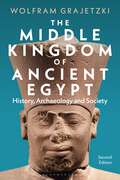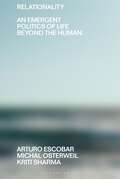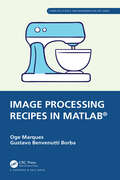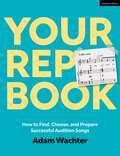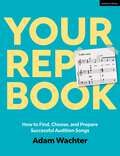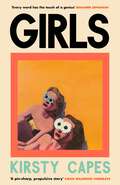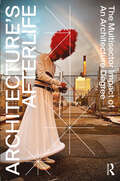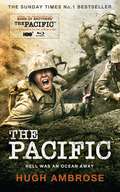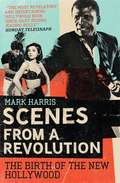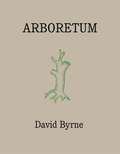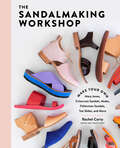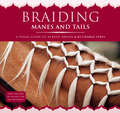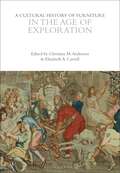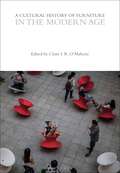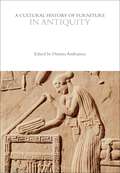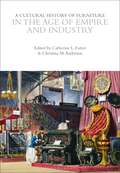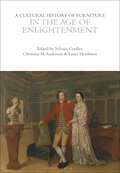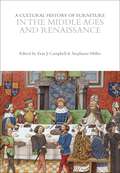- Table View
- List View
The Middle Kingdom of Ancient Egypt: History, Archaeology and Society
by Wolfram GrajetzkiFor the ancient Egyptians, the Middle Kingdom (c. 2000-1700 BC) was a classical period of art, history and literature. The Twelfth Dynasty was one of the strongest ever to rule on the banks of the Nile: some of its kings were later worshipped as local gods, and were made famous by classical Greek authors. Yet Egyptologists tend not to look beyond the extraordinary royal sculpture and literary masterpieces of the time. Although the picture is fragmentary, as with any archaeological record, the last two hundred years of exploration and excavation have revealed much of the splendour of the period. This book examines the evidence for the culture, history and society of both central and provincial Egypt at the time, revealing the wealth of the entire country. In this second edition, Wolfram Grajetzki incorporates recent discoveries, discussions and publications which have emerged over the intervening fifteen years, including new excavation reports for the mastabas at Lisht and excavations at Abydos. Too often overshadowed by the better-preserved architecture of other periods, Middle Kingdom Egypt emerges for the reader as a fascinating age in its own right.
Relationality: An Emergent Politics of Life Beyond the Human (Beyond the Modern)
by Arturo Escobar Michal Osterweil Kriti SharmaThis important new book argues that at the root of the contemporary crisis of climate, energy, food, inequality, and meaning is a certain core presupposition that structures the ways in which we live, think, act and design: the assumption of dualism, or the fundamental separateness of things.The authors contend that the key to constructing livable worlds lies in the cultivation of ways of knowing and acting based on a profound awareness of the fundamental interdependence of everything that exists – what they refer to as relationality. This shift in paradigm is necessary for healing our bodies, ecosystems, cities, and the planet at large. The book follows two interwoven threads of argumentation: on the one hand, it explains and exemplifies the modes of operation and the dire consequences of non-relational living; on the other, it elucidates the nature of relationality and explores how it is embodied in transformative practices in multiple spheres of life.The authors provide an instructive account of the philosophical, scientific, social, and political sources of relational theory and action, with the aim of illuminating the transition from living within seemingly ineluctable 'toxic loops' of unrelational living (based on ontological dualism), to living within 'relational weaves' which we might co-create with multiple human and nonhuman others.
Image Processing Recipes in MATLAB® (Chapman & Hall/CRC Computer Science and Engineering Recipes Series)
by Oge Marques Gustavo Benvenutti BorbaLeveraging the latest developments in MATLAB and its image processing toolbox, this 'cookbook' is a collection of 30 practical recipes for image processing, ranging from foundational techniques to recently published algorithms. Presented in a clear and meaningful sequence, these recipes are prepared with the reader in mind, allowing one to focus on particular topics or read as a whole from cover to cover.Key Features: A practical, user-friendly guide that equips researchers and practitioners with the tools to implement efficient image processing workflows in MATLAB. Each recipe is presented through clear, step-by-step instructions and rich visual examples. Each recipe contains its own source code, explanations, and figures, making the book an excellent standalone resource for quick reference. Strategically structured to aid sequential learning, yet with self-contained chapters for those seeking solutions to specific image processing challenges. The book serves as a concise and readable practical reference to deploy image processing pipelines in MATLAB quickly and efficiently. With its accessible and practical approach, the book is a valuable guide for those who navigate this evolving area, including researchers, students, developers, and practitioners in the fields of image processing, computer vision, and image analysis.
Image Processing Recipes in MATLAB® (Chapman & Hall/CRC Computer Science and Engineering Recipes Series)
by Oge Marques Gustavo Benvenutti BorbaLeveraging the latest developments in MATLAB and its image processing toolbox, this 'cookbook' is a collection of 30 practical recipes for image processing, ranging from foundational techniques to recently published algorithms. Presented in a clear and meaningful sequence, these recipes are prepared with the reader in mind, allowing one to focus on particular topics or read as a whole from cover to cover.Key Features: A practical, user-friendly guide that equips researchers and practitioners with the tools to implement efficient image processing workflows in MATLAB. Each recipe is presented through clear, step-by-step instructions and rich visual examples. Each recipe contains its own source code, explanations, and figures, making the book an excellent standalone resource for quick reference. Strategically structured to aid sequential learning, yet with self-contained chapters for those seeking solutions to specific image processing challenges. The book serves as a concise and readable practical reference to deploy image processing pipelines in MATLAB quickly and efficiently. With its accessible and practical approach, the book is a valuable guide for those who navigate this evolving area, including researchers, students, developers, and practitioners in the fields of image processing, computer vision, and image analysis.
Relationality: An Emergent Politics of Life Beyond the Human (Beyond the Modern)
by Arturo Escobar Michal Osterweil Kriti SharmaThis important new book argues that at the root of the contemporary crisis of climate, energy, food, inequality, and meaning is a certain core presupposition that structures the ways in which we live, think, act and design: the assumption of dualism, or the fundamental separateness of things.The authors contend that the key to constructing livable worlds lies in the cultivation of ways of knowing and acting based on a profound awareness of the fundamental interdependence of everything that exists – what they refer to as relationality. This shift in paradigm is necessary for healing our bodies, ecosystems, cities, and the planet at large. The book follows two interwoven threads of argumentation: on the one hand, it explains and exemplifies the modes of operation and the dire consequences of non-relational living; on the other, it elucidates the nature of relationality and explores how it is embodied in transformative practices in multiple spheres of life.The authors provide an instructive account of the philosophical, scientific, social, and political sources of relational theory and action, with the aim of illuminating the transition from living within seemingly ineluctable 'toxic loops' of unrelational living (based on ontological dualism), to living within 'relational weaves' which we might co-create with multiple human and nonhuman others.
Your Rep Book: How to Find, Choose, and Prepare Successful Audition Songs
by Adam WachterPrepping songs for Musical Theatre auditions can be more stressful and confusing than a bad production of Sweeney Todd... but this book can help. How do you find the right songs, and in all the various genres? Where do you get the sheet music? How do you edit it down to make your 16- or 32-bar cut? What even is a 16-bar cut?! Relax, diva: Your Rep Book has the answers to all these questions and so many more. Adam Wachter has taught courses on audition repertoire selection at top conservatories in the US and UK and spent years accompanying and sitting “behind the table” in auditions for everything from university programs to Broadway shows. This friendly and accessible guide is designed to answer all your questions and help you stock that rep book with tight cuts of great songs so you can walk into your next audition and totally nail it. Including a foreword by Broadway casting director Rachel Hoffman and an afterword by Broadway and West End star Caissie Levy, Your Rep Book takes its readers step-by-step through the strangely mysterious process of building your audition repertoire portfolio (or “rep book” in industry jargon). Leaving no stone – or showtune – unturned, it helps you identify what songs you need in which categories and explains where to find them, how to source and cut the sheet music, and even how to communicate effectively with the accompanist and act your song. Whether you're a high school student auditioning for college MT programs or the ink is still wet on your recent BFA, or even if you're a seasoned pro dusting off those old charts, Your Rep Book is here to help!
Your Rep Book: How to Find, Choose, and Prepare Successful Audition Songs
by Adam WachterPrepping songs for Musical Theatre auditions can be more stressful and confusing than a bad production of Sweeney Todd... but this book can help. How do you find the right songs, and in all the various genres? Where do you get the sheet music? How do you edit it down to make your 16- or 32-bar cut? What even is a 16-bar cut?! Relax, diva: Your Rep Book has the answers to all these questions and so many more. Adam Wachter has taught courses on audition repertoire selection at top conservatories in the US and UK and spent years accompanying and sitting “behind the table” in auditions for everything from university programs to Broadway shows. This friendly and accessible guide is designed to answer all your questions and help you stock that rep book with tight cuts of great songs so you can walk into your next audition and totally nail it. Including a foreword by Broadway casting director Rachel Hoffman and an afterword by Broadway and West End star Caissie Levy, Your Rep Book takes its readers step-by-step through the strangely mysterious process of building your audition repertoire portfolio (or “rep book” in industry jargon). Leaving no stone – or showtune – unturned, it helps you identify what songs you need in which categories and explains where to find them, how to source and cut the sheet music, and even how to communicate effectively with the accompanist and act your song. Whether you're a high school student auditioning for college MT programs or the ink is still wet on your recent BFA, or even if you're a seasoned pro dusting off those old charts, Your Rep Book is here to help!
Girls: The stunning new novel from the Women’s Prize longlisted author of CARELESS
by Kirsty Capes*Don't miss the searing, dazzling and unforgettable new novel from the Women's Prize longlisted author of CARELESS!*'Every word has the touch of a genius' BENJAMIN ZEPHANIAH'Expect to see this on every sun lounger this summer!' THE SHIFT'A pin-sharp, propulsive story' KIRAN MILLWOOD HARGRAVE'Daisy Jones and the Six fans will love this!' GRAZIA'I was bereft when I finished. A contender for my books of the year list' PRIMA'Bold, brilliant, shocking and shattering' CHRIS WHITAKEREveryone has heard of Girls.But what happened to the women they became?At the time of her death, the press wrote many things about Ingrid Olssen:She was a brilliant artist. She was a terrible mother to her girls, Mattie and Nora. And that her legacy would live on forever.Even so, it's unlikely the world will ever see another Ingrid Olssen exhibition - her last request to her daughters was to throw her ashes in the canyon and her paintings in the sea.But as Mattie and Nora reluctantly embark on an all-or-nothing trip to fulfil her wishes, they start to unpick the painful scars of their past.And soon they begin to realise that the ties that bound them, might also break them...Perfect for fans of Sorrow and Bliss by Meg Mason and Daisy Jones and the Six by Taylor Jenkins Reid. GIRLS is as devastating as it is hilarious, as tender and moving as it is shocking - this is a book that will stay with you long after you have turned the final pages.** PRAISE FOR GIRLS **'I knew I'd love GIRLS and I did, but I'm also utterly devastated by it. What a beautiful, rich, expansive novel. It'll be a while before I stop crying. Thank you a million times over' JENNIE GODFREY'I can't think when I last encountered a story world of this depth and faultless plausibility. Everything about it was perfect: intricate; warm; uncluttered. Blimey, I wish I'd written it' ANSTEY HARRIS'An extraordinary writer of lives rarely written about [...] in words that are wise, warm, painful and often witty' DALJIT NAGRA'Raw, vivid, complex, painful and unexpectedly funny too - a brilliantly original novel that really gets under your skin' JOANNA GLEN'Phenomenal. I loved it.' KATE SAWYER'Surprising, heart-breaking and dryly funny, Kirsty Capes is such an exciting talent.' CAROLINE HULSE'GIRLS puts a lens to the awful things sisters do to one another and the absolute life-changing necessity of a sister's forgiveness.' ABIGAIL BERGSTROM'Ambitious in form and scope, it covers childhood trauma, art and celebrity culture, the unfathomable bond between sisters, and much more' ELISSA SOAVE'Unmissable, bold and moving. This is Capes' best novel yet.' SARA JAFARI'Thoughtful and deeply human, Girls is a masterful take on family at its most complicated' PHOENICIA ROGERSON'Phenomenal. GIRLS made me laugh, cry, and gave me all the feels in between. I'll be thinking about these characters for a very long time' LISA HALL'Wonderful, wonderful storytelling and unforgettable characters' SARA NISHA ADAMS
Architecture's Afterlife: The Multisector Impact of an Architecture Degree
by Michela Barosio Dag Boutsen Andrea Čeko Haydée De Loof Johan De Walsche Santiago Gomes Harriet Harriss Roberta Marcaccio Mia Roth-Čerina Carla Sentieri Neal Sashore Federica Vannucchi Hanne Van ReuselAlmost 40% of architecture graduates choose not to practise as architects. Instead, by ‘leaving’ their chosen profession, this surprisingly large but vastly overlooked cohort are making significant contributions to a wide range of other sectors, from politics to videogame design, demonstrating that architectural training can be a pathway to roles, and even leadership opportunities, across a variety of other professions.Architecture’s Afterlife is the first book to examine the sectors into which these graduates migrate, and to identify the transferable skills that are learned, but not always taught, in their degree programmes, and that prove most useful in their new careers.The book – a result of a three-year pan-European study funded by Erasmus+ – provides a roadmap for increasing graduate employment, addressing skills shortages across all sectors and adapting curricula to changing professional landscapes. It is therefore essential reading for all those responsible for curriculum design and delivery in architecture and other disciplines, including deans, professors, postgraduate researchers and policy makers, as well as students and professionals seeking to expand their career prospects.
Architecture's Afterlife: The Multisector Impact of an Architecture Degree
by Michela Barosio Dag Boutsen Andrea Čeko Haydée De Loof Johan De Walsche Santiago Gomes Harriet Harriss Roberta Marcaccio Mia Roth-Čerina Carla Sentieri Neal Sashore Federica Vannucchi Hanne Van ReuselAlmost 40% of architecture graduates choose not to practise as architects. Instead, by ‘leaving’ their chosen profession, this surprisingly large but vastly overlooked cohort are making significant contributions to a wide range of other sectors, from politics to videogame design, demonstrating that architectural training can be a pathway to roles, and even leadership opportunities, across a variety of other professions.Architecture’s Afterlife is the first book to examine the sectors into which these graduates migrate, and to identify the transferable skills that are learned, but not always taught, in their degree programmes, and that prove most useful in their new careers.The book – a result of a three-year pan-European study funded by Erasmus+ – provides a roadmap for increasing graduate employment, addressing skills shortages across all sectors and adapting curricula to changing professional landscapes. It is therefore essential reading for all those responsible for curriculum design and delivery in architecture and other disciplines, including deans, professors, postgraduate researchers and policy makers, as well as students and professionals seeking to expand their career prospects.
The Pacific (The Official HBO/Sky TV Tie-In): Hell Was An Ocean Away
by Hugh AmbroseSidney C. Philips, an easygoing Alabama teenager, enlisted along with a friend. 'Manila John' Basilone was the son of immigrants who found happiness in the rough-and-ready life of a marine. Eugene B. Sledge watched his best friend and brother go off to war - and finally rebelled against his parents to follow them. 'Shifty' Shofner was the scion of a prominent family with a long record of military service. Ensign Vernon 'Mike' Micheel left the family farm to complete flight school. Between America's retreat from China in late 1941 and the moment that MacArthur's plane landed in Japan in August 1945, these five men fought many of the key battles of the war in the Pacific. Here, Hugh Ambrose focuses on their real-life experiences and those of their fellow servicemen, enhancing and expanding upon the story told in the HBO miniseries. Covering nearly four years of combat with unprecedented access to military records, letters, journals, memoirs, photographs and interviews, this volume offers a unique historical perspective on the war against Japan, from the debacle in Bataan to the miracle of Midway, the relentless vortex of Guadalcanal, the black terraces of Iwo Jima and the killing fields of Okinawa - and ultimately the triumphant yet uneasy return home. These are the true stories of the men who put their lives on the line for their country, who were dispatched to the other side of the world to fight an enemy who preferred suicide to surrender; men who suffered hardship and humiliation in POW camps; men who witnessed casualties among soldiers and civilians alike; and men whose medals came at a shocking price - a price paid in full by all.
Scenes From A Revolution: The Birth of the New Hollywood
by Mark HarrisWith behind-the-scenes gossip creating as much drama as the movies themselves, Hollywood in 1967 showcased the future of film in more ways than one. From the anti-heroes of Bonnie and Clyde and the illicit sex of The Graduate to the race relations of In The Heat of the Night, suddenly no subject was taboo. This was a time of turbulence as hip young filmmakers embodying the restlessness and rebellion of a changing America wrought radical changes to the traditions of cinema. Scenes from a Revolution is an exceptional analysis of the films shortlisted for the Best Picture Academy Award of 1967 as well as an illuminating window into the popular culture of the time.
Arboretum
by David ByrneFor over thirty years, besides making music, David Byrne has focused his unique genius upon forms as diverse as the archaeology of music as we know it, architectural photography and the uses of PowerPoint. Now he presents his most personal work to date, a collection of drawings exploring the form of the tree diagram. Arboretum is an eclectic blend of science, automatic writing, self-analysis and satire. A journey through irrational logic - the application of scientific rigour and form to irrational premises, proceeding from careful nonsense to unexpected sense. The tree diagram is a form that might reveal more about yourself than you dreamed possible.
The Sandalmaking Workshop: Make Your Own Mary Janes, Crisscross Sandals, Mules, Fisherman Sandals, Toe Slides, and More
by Rachel CorryCustom-fit for comfort, custom-designed to suit personal taste, and stylish and satisfyingly DIY? Shoemaking checks all the boxes! Making shoes is a surprisingly accessible and increasingly popular craft, and with this photo-rich guide, even a beginner can make a comfortable pair of sandals in the course of a day with just a few simple tools and materials. From setting up a workshop and refining a design to making uppers, attaching soles, and adding finishing touches like buckles or studs, The Sandalmaking Workshop takes readers step by step through the process of creating modern leather sandals that are stylish and comfortable. The book includes traceable patterns for 14 of author Rachel Corry&’s original sandal designs—both open- and closed-toe styles, including mules and slides—and covers a range of techniques so readers can build their skills and stretch the creative possibilities with each new pair they make. This publication conforms to the EPUB Accessibility specification at WCAG 2.0 Level AA.
Braiding Manes and Tails: A Visual Guide to 30 Basic Braids
by Charni LewisGive your horse a gorgeous look! Charni Lewis provides step-by-step instructions for 30 mane and tail braids for both casual outings and specialized events of all riding styles. Full-color photographs and detailed illustrations bring every twist and turn to life, while also clearly demonstrating proper hand positioning. Get inspired and experiment with a Scalloped mane braid or a Four-Strand Weave for the tail. Not only will your horse look great, the time you spend braiding will help develop that special bond between you and your horse.
A Cultural History of Furniture in the Age of Exploration (The Cultural Histories Series)
by Professor Megan AldrichThe 16th and 17th centuries in Europe witnessed a significant paradigm shift. Rooted in medieval beliefs and preoccupations, the exploration so characteristic of the period stemmed from religious motives but came to be propelled by commerce and curiosity as Europeans increasingly engaged with the rest of the world. Interiors in both public and private spaces changed to reflect these cultural encounters and, with them, the furniture with which they were populated. Visually, furniture of this period displayed new designs, forms and materials. In its uses, it also mirrored developments in science, technology, government and social relationships as prints became more widely distributed, the Wunderkammer developed and there was religious strife and resistance to absolute monarchical rule.Drawing upon a wealth of visual and textual sources, this volume presents essays that examine key characteristics of the furniture of the period on the themes of Design and Motifs; Makers, Making, and Materials; Types and Uses; The Domestic Setting; The Public Setting; Exhibition and Display; Furniture and Architecture; Visual Representations; and Verbal Representations.
A Cultural History of Furniture in the Modern Age (The Cultural Histories Series)
Furniture is a unique witness to the transformations of private and public experience amidst the upheavals of the 20th century. How we work, rest and play are determined by the embodied encounter with furniture, defining and projecting a sense of identity and status, responding to and exemplifying contrasting social conditions, political and economic motivations, aesthetic predilections and debates. Assessing physical and archival evidence drawn from a spectrum of iconic and under-represented case studies, an international team of design historians collaborate in this volume to explore key methodological questions about how the production, consumption and mediation of furniture reveal shifting cultural habits and histories across diverse contexts amidst modernity. Drawing upon a wealth of visual and textual sources, this volume presents essays that examine key characteristics of the furniture of the period on the themes of Design and Motifs; Makers, Making, and Materials; Types and Uses; The Domestic Setting; The Public Setting; Exhibition and Display; Furniture and Architecture; Visual Representations; and Verbal Representations.
A Cultural History of Furniture in Antiquity (The Cultural Histories Series)
by Dimitra AndrianouCovering the period from 2500 BCE to the Byzantine Era, this volume focuses on the social history of furniture found in houses, tombs and temples as narrated through the archaeological evidence. The earliest furniture can be seen as an attempt by humans to enhance their safety, comfort and social standing but it can also offer opportunities for understanding human behavior, values and thought: fine furniture was among the most valuable of possessions in the ancient world so it expressed power, wealth and status. It was appreciated as art, used in diplomacy (both as a gift and as tribute) and recorded as booty. At the same time, its practical and ceremonial uses yield important clues about the domestic environment and daily life in antiquity, as well as revealing aspects of sacred belief and funerary practices.Drawing upon a wealth of visual and textual sources, this volume presents essays that examine key characteristics of the furniture of the period on the themes of Design and Motifs; Makers, Making, and Materials; Types and Uses; The Domestic Setting; The Public Setting; Exhibition and Display; Furniture and Architecture; Visual Representations; and Verbal Representations.
A Cultural History of Furniture in Antiquity (The Cultural Histories Series)
Covering the period from 2500 BCE to the Byzantine Era, this volume focuses on the social history of furniture found in houses, tombs and temples as narrated through the archaeological evidence. The earliest furniture can be seen as an attempt by humans to enhance their safety, comfort and social standing but it can also offer opportunities for understanding human behavior, values and thought: fine furniture was among the most valuable of possessions in the ancient world so it expressed power, wealth and status. It was appreciated as art, used in diplomacy (both as a gift and as tribute) and recorded as booty. At the same time, its practical and ceremonial uses yield important clues about the domestic environment and daily life in antiquity, as well as revealing aspects of sacred belief and funerary practices.Drawing upon a wealth of visual and textual sources, this volume presents essays that examine key characteristics of the furniture of the period on the themes of Design and Motifs; Makers, Making, and Materials; Types and Uses; The Domestic Setting; The Public Setting; Exhibition and Display; Furniture and Architecture; Visual Representations; and Verbal Representations.
A Cultural History of Furniture in the Age of Empire and Industry (The Cultural Histories Series)
by Catherine L. Futter and Christina M. AndersonThe 19th century in Western culture was a time of both confidence and turbulence. Industrial developments resulted in a number of benefits from a growing middle class to efficiency, convenience and innovation across a range of fields from engineering to architecture. Alongside these improvements, the century began with the extended period of the Napoleonic Wars and was further disrupted by rebellions and revolutions both within Europe and in India, South America and other parts of the world. Slavery was abolished and urbanization increased dramatically.These myriad developments were reflected throughout the period in the proliferation of types of furniture, along with their categorization as 'industrial art' at the international exhibitions and world fairs and the increasingly adventurous range of materials that were sometimes used in their construction. Nonetheless, a strong antiquarian/historicist strand also prompted interest in the revival of past styles in areas of art and design, including furniture. Drawing upon a wealth of visual and textual sources, this volume presents essays that examine key characteristics of the furniture of the period on the themes of Design and Motifs; Makers, Making, and Materials; Types and Uses; The Domestic Setting; The Public Setting; Exhibition and Display; Furniture and Architecture; Visual Representations; and Verbal Representations.
A Cultural History of Furniture in the Modern Age (The Cultural Histories Series)
by Claire I. R. O’MahonyFurniture is a unique witness to the transformations of private and public experience amidst the upheavals of the 20th century. How we work, rest and play are determined by the embodied encounter with furniture, defining and projecting a sense of identity and status, responding to and exemplifying contrasting social conditions, political and economic motivations, aesthetic predilections and debates. Assessing physical and archival evidence drawn from a spectrum of iconic and under-represented case studies, an international team of design historians collaborate in this volume to explore key methodological questions about how the production, consumption and mediation of furniture reveal shifting cultural habits and histories across diverse contexts amidst modernity. Drawing upon a wealth of visual and textual sources, this volume presents essays that examine key characteristics of the furniture of the period on the themes of Design and Motifs; Makers, Making, and Materials; Types and Uses; The Domestic Setting; The Public Setting; Exhibition and Display; Furniture and Architecture; Visual Representations; and Verbal Representations.
A Cultural History of Furniture in the Age of Enlightenment (The Cultural Histories Series)
by Sylvain Cordier, Christina M. Anderson, and Laura HoulistonThe 18th century saw the height of court culture in Europe as well as the beginnings of its demise with conflicts such as the American and French Revolutions. The Scientific Revolution, which had begun in the preceding centuries, also ushered in a new intellectual era which advocated the use of reason to effect change in government and to advance progress in society. For furniture, this meant ever-higher standards of luxury in the designs, techniques and materials utilized for the best pieces, and more structure and specialization in the furniture-making process itself. Furniture also came into its own during this period as a collectable work of art on its own merits.Drawing upon a wealth of visual and textual sources, this volume presents essays that examine key characteristics of the furniture of the period on the themes of Design and Motifs; Makers, Making, and Materials; Types and Uses; The Domestic Setting; The Public Setting; Exhibition and Display; Furniture and Architecture; Visual Representations; and Verbal Representations.
A Cultural History of Furniture in the Age of Enlightenment (The Cultural Histories Series)
The 18th century saw the height of court culture in Europe as well as the beginnings of its demise with conflicts such as the American and French Revolutions. The Scientific Revolution, which had begun in the preceding centuries, also ushered in a new intellectual era which advocated the use of reason to effect change in government and to advance progress in society. For furniture, this meant ever-higher standards of luxury in the designs, techniques and materials utilized for the best pieces, and more structure and specialization in the furniture-making process itself. Furniture also came into its own during this period as a collectable work of art on its own merits.Drawing upon a wealth of visual and textual sources, this volume presents essays that examine key characteristics of the furniture of the period on the themes of Design and Motifs; Makers, Making, and Materials; Types and Uses; The Domestic Setting; The Public Setting; Exhibition and Display; Furniture and Architecture; Visual Representations; and Verbal Representations.
A Cultural History of Furniture in the Age of Empire and Industry (The Cultural Histories Series)
The 19th century in Western culture was a time of both confidence and turbulence. Industrial developments resulted in a number of benefits from a growing middle class to efficiency, convenience and innovation across a range of fields from engineering to architecture. Alongside these improvements, the century began with the extended period of the Napoleonic Wars and was further disrupted by rebellions and revolutions both within Europe and in India, South America and other parts of the world. Slavery was abolished and urbanization increased dramatically.These myriad developments were reflected throughout the period in the proliferation of types of furniture, along with their categorization as 'industrial art' at the international exhibitions and world fairs and the increasingly adventurous range of materials that were sometimes used in their construction. Nonetheless, a strong antiquarian/historicist strand also prompted interest in the revival of past styles in areas of art and design, including furniture. Drawing upon a wealth of visual and textual sources, this volume presents essays that examine key characteristics of the furniture of the period on the themes of Design and Motifs; Makers, Making, and Materials; Types and Uses; The Domestic Setting; The Public Setting; Exhibition and Display; Furniture and Architecture; Visual Representations; and Verbal Representations.
A Cultural History of Furniture in the Middle Ages and Renaissance (The Cultural Histories Series)
The Middle Ages were marked by dramatic social, economic, political, and religious changes. Diverse regional and local conditions, and varied social classes - including peasant, artisan, merchant, clergy, nobility, and rulers - resulted in differing needs for furniture. The social settings for furniture included official and private residences both grand and humble, churches and monasteries, and civic institutions, including places of governance and learning, such as municipal halls, guild halls, and colleges. This volume explores how furniture contributed to the social fabric within these varied spaces.The chronological range of this volume extends from the fall of the Roman Empire through to the early Renaissance, a period which exhibited a wide array of types, styles, and motifs, including Byzantine, Romanesque, Gothic, and Renaissance. Rural and regional styles of furniture are also considered, as well as techniques of furniture manufacture. Drawing upon a wealth of visual and textual sources, this volume presents essays that examine key characteristics of the furniture of the period on the themes of Design and Motifs; Makers, Making, and Materials; Types and Uses; The Domestic Setting; The Public Setting; Exhibition and Display; Furniture and Architecture; Visual Representations; and Verbal Representations.
